Related Research Articles

An aircraft engine, often referred to as an aero engine, is the power component of an aircraft propulsion system. Most aircraft engines are either piston engines or gas turbines, although a few have been rocket powered and in recent years many small UAVs have used electric motors.

The Thielert Centurion is a series of Diesel cycle aircraft engines for general aviation originally built by Thielert, which was bought by Aviation Industry Corporation of China's Tecnify Motors subsidiary and is currently marketed by Continental Motors. They are based on heavily modified Mercedes-Benz automotive engines.

The Klimov VK-107 was a V-12 liquid-cooled piston aircraft engine used by Soviet aircraft during World War II.

The aircraft diesel engine or aero diesel is a diesel-powered aircraft engine. They were used in airships and tried in aircraft in the late 1920s and 1930s, but never widely adopted beyond this. Their main advantages are their excellent specific fuel consumption, the reduced flammability and somewhat higher density of their fuel, but these have been outweighed by a combination of inherent disadvantages compared to gasoline-fueled or turboprop engines. The ever-rising cost of avgas and doubts about its future availability have spurred a resurgence in aircraft diesel engine production in the early 2010s.
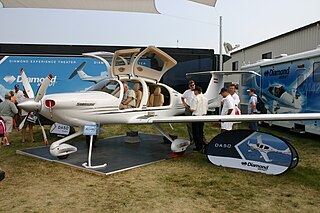
The Diamond DA50 is a five-place, single-engine, composite aircraft designed and built by Diamond Aircraft Industries. First shown in 2006, it made its maiden flight on 4 April 2007. The project has been proposed to be powered by several different engines, but was certified on 9 September 2020 with the Continental CD-300 diesel.
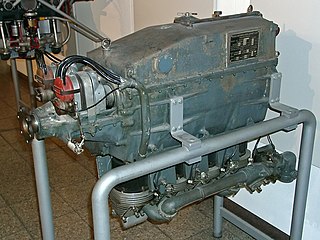
The Argus As 8 was a four-cylinder, air-cooled, inverted inline aircraft engine produced in Germany by Argus Motoren in the 1930s.

The Hirth HM 504 is a four-cylinder air-cooled inverted inline engine. The HM 504 was a popular engine for light aircraft of the 1930s-1940s, and it was used to power a number of Germany's trainer aircraft of World War II. The engine featured a cast magnesium alloy crankcase. The Hitachi Hatsukaze Model 11 was a Japanese licensed version.

The Argus As 410 was a German air-cooled inverted V-12 light aircraft engine that was first produced by Argus Motoren in 1938.
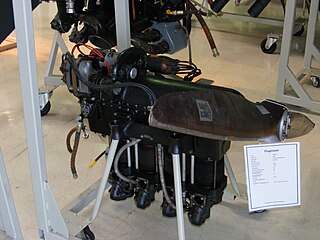
The Hirth HM 60 was a four-cylinder inverted air-cooled inline aircraft engine designed in 1923 and first sold in 1924. The engine was of very high quality, and its sales success contributed to Hirth's rapid pre-war expansion. It was a popular engine for light aircraft delivering 80 hp (60 kW) at 2,300 rpm. Later Hirth engines built upon the HM 60's success and provided greater power with many of the same design features.

The Continental IO-360 is a family of fuel-injected air-cooled, horizontally opposed six-cylinder aircraft engines manufactured by Continental Motors in the United States of America, now part of AVIC International since 2010.

The Continental IO-550 engine is a large family of fuel injected six-cylinder, horizontally opposed, air-cooled aircraft engines that were developed for use in light aircraft by Teledyne Continental Motors. The first IO-550 was delivered in 1983 and the type remains in production.
The Lycoming GSO-580 is a family of eight-cylinder horizontally opposed, supercharged, carburetor-equipped aircraft engines for both airplanes and helicopters, manufactured by Lycoming Engines in the late 1950s and early 1960s.

The Lycoming IO-390 engine is a horizontally opposed, four-cylinder aircraft engine, manufactured by Lycoming Engines.

The Beardmore Tornado was an eight-cylinder inline diesel aircraft engine built in 1927 by William Beardmore and Company of Glasgow, Scotland, and used in the British R101 airship when petrol engines were thought unsafe in the tropics. The model is given as Tornado IIIA or Tornado III C.I. The fuel is described as Diesel heavy-oil..

The Daimler-Benz DB 602, originally known as Daimler-Benz LOF.6, was a German diesel cycle aero engine designed and built in the early 1930s. It was a liquid-cooled upright V16, and powered the two Hindenburg class airships. It has roughly the same displacement and weight of the Beardmore Tornado, which was used in the ill-fated R101, but has almost twice the power of the Tornado, showing Daimler-Benz's superior knowledge regarding diesel engine construction.
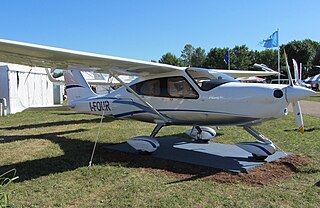
The Tecnam 2010 is a four-seat, high wing, single engine light aircraft of mixed metal and carbon-fiber-reinforced polymer construction. Designed and built in Italy, it was first presented in public in April 2011.
The Zoche aero-diesels are a trio of radical German prototype diesel radial aero-engines intended for light aircraft, designed by Michael and Georg Zoche in the 1990s. Zoche aero-diesels are modular piston engines and are all direct-drive, air-cooled, radial two-stroke diesels with up to four cylinders per row. They all feature direct fuel-injection, two-stage charging, and intercooling. In each plane, all the pistons connect to a single throw on the crankshaft.
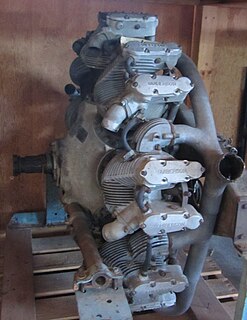
The Guiberson A-1020 is a four-stroke diesel radial engine developed for use in aircraft and tanks.
The Franklin O-500 was an American air-cooled aircraft engine that first ran in the mid-1940s. The engine was of six-cylinder, horizontally-opposed layout and displaced 500 cu in (8 L). The power output was 215 hp (160 kW).
The Beardmore Cyclone was an aero engine produced by William Beardmore & Co with the aim of producing an engine generating a high power output at low revolutions by designing an engine of large displacement. The design did not enter volume production.
References
- 1 2 3 "Engine Overview". Engineered Propulsion Systems.
- 1 2 Pia Bergqvist (July 7, 2017). "EPS Diesel Engine Nears Certification". Flying Magazine.
- 1 2 3 Mark Huber (July 25, 2018). "EPS Continues To Make Progress on Aero Diesel". AIN online.
- ↑ "EPS Making Progress on Certification of Vision 350 Flat-V Diesel Aero-Engine" (Press release). EPS. July 9, 2013.
- ↑ Thomas B Haines (October 5, 2015). "DIESEL ROUNDS THE BEND NEW FUNDS SPUR NEXTGEN DIESEL ENGINES". AOPA.
- ↑ "Fuel Economy". Engineered Propulsion Systems.
- ↑ Addison Schonland (March 26, 2018). "EPS Diesel Progressing Toward Certification". AirInsight.
- 1 2 3 O'Connor, Kate (August 11, 2020). "EPS Files For Bankruptcy". AVweb. Archived from the original on August 12, 2020. Retrieved August 12, 2020.